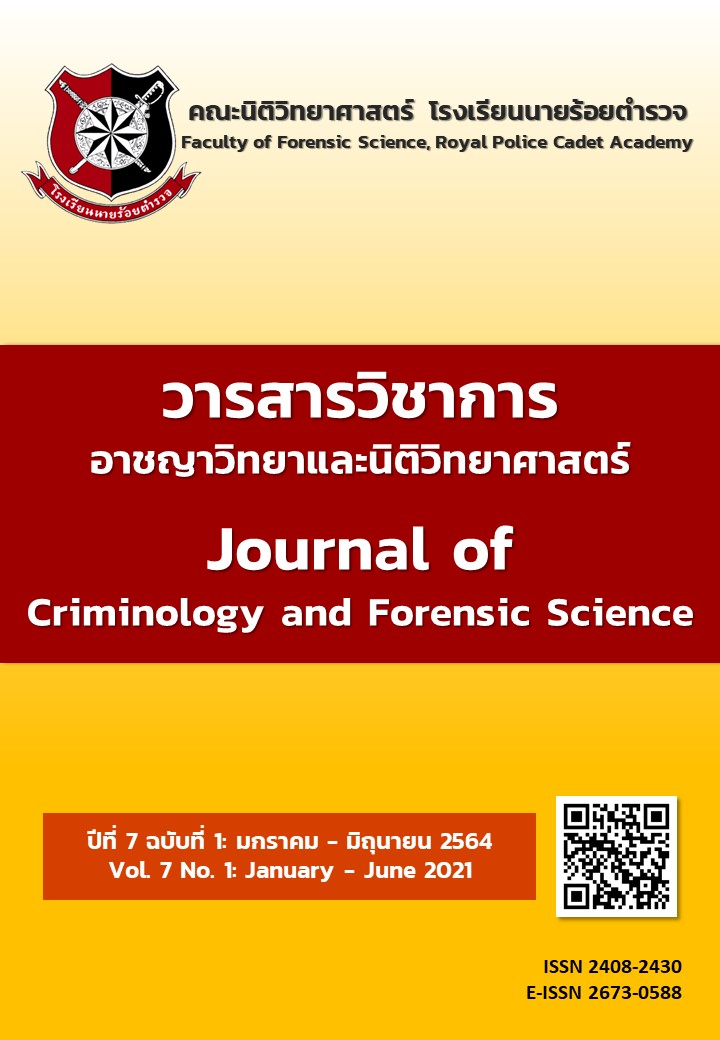การตรวจประมาณหาอายุของคราบอสุจิบนวัตถุรองรับและอุณหภูมิที่แตกต่างกัน
Main Article Content
บทคัดย่อ
งานวิจัยครั้งนี้มีวัตถุประสงค์เพื่อศึกษาลักษณะพื้นผิวและธาตุองค์ประกอบทางเคมีในเส้นใยของผ้า 3 ชนิด ได้แก่ ผ้าโทเร TR ผ้ายีนส์ และผ้าสแลค เพื่อเปรียบเทียบคราบน้ำอสุจิบนผ้าจำนวน 3 ชนิด ในสภาวะอุณหภูมิเย็น (4-8 °C) อุณหภูมิห้อง (24-29 °C) อุณหภูมิร้อน (30-35 °C) โดยตรวจวัดในช่วงเวลาที่แตกต่างกันเพื่อหาอายุของคราบน้ำอสุจิบนผ้าทั้ง 3 ชนิด
ผลการวิจัยพบว่า น้ำอสุจิมีส่วนประกอบหลักคือน้ำ (H2O) และกรดอะมิโน (C, H, O, N) ซึ่งงานวิจัยนี้สนใจศึกษาธาตุที่เคลือบอยู่บนพื้นผิวผ้าหลังหยดอสุจิ 1, 3, 13 วัน ในผ้าทั้ง 3 ชนิด ที่มีธาตุองค์ประกอบ 2 ชนิด คือ คาร์บอน (C) และออกซิเจน (O) จากนั้นทำการตรวจวิเคราะห์องค์ประกอบทางเคมี (%wt) ของคราบน้ำอสุจิบนผ้าด้วยวิธี EDS ที่สามารถตรวจได้เฉพาะพื้นผิว ผลการทดลองพบว่าเมื่อเวลาผ่านไปคาร์บอน (C) จะมีปริมาณ %wt เพิ่มขึ้น เนื่องจากมีการสลายตัวของคราบอสุจิที่เคลือบอยู่บนพื้นผิวผ้าทำให้สามารถตรวจลึกลงถึงเส้นใยของผ้า ส่วนออกซิเจน (O) จะมีปริมาณ %wt ลดลงเนื่องจากมีการสลายตัวของส่วนประกอบหลักที่เป็นน้ำของคราบอสุจิที่เคลือบอยู่บนพื้นผิวผ้าจนใกล้เคียงกับปริมาณองค์ประกอบทางเคมีของผ้าที่ไม่มีคราบอสุจิ และพบว่าในวันที่ 1 ยังพบการเกาะตัวของคราบอสุจิบนพื้นผิวมากกว่าช่วงระยะเวลาอื่นแสดงให้เห็นว่าการประมาณอายุของคราบน้ำอสุจิด้วยเทคนิคกล้องจุลทรรศน์อิเล็กตรอนแบบส่องกราด สามารถยืนยันคราบน้ำอสุจิประมาณเบื้องต้นโดยไม่ทำลายตัวอย่าง
Article Details
เนื้อหาและข้อมูลในบทความที่ลงตีพิมพ์ใน วารสารวิชาการอาชญาวิทยาและนิติวิทยาศาสตร์ โรงเรียนนายร้อยตำรวจ ถิอว่าเป็นข้อคิดเห็นและความรั้บผิดชอบของผู้เขียนบทความโดยตรงซึ่งกองบรรณาธิการวารสาร ไม่จำเป็นต้องเห็นด้วยหรือรับผิดชอบใดๆ
บทความ ข้อมูล เนื้อหา รูปภาพ ฯลฯ ที่ได้รับการตีพิมพ์ใน วารสารวิชาการอาชญาวิทยาและนิติวิทยาศาสตร์ ถือว่าเป็นลิขสิทธิ์ของวารสาร วารสารวิชาการอาชญาวิทยาและนิติวิทยาศาสตร์ หากบุคคลหรือหน่วยงานใดต้องการนำทั้งหมดหรือส่วนหนึ่งส่วนใดไปเผยแพร่ต่อหรือเพื่อกระทำการใดๆ จะต้องได้รับอนุญาตเป็นลายลักษณ์อักษรจาก วารสารวิชาการอาชญาวิทยาและนิติวิทยาศาสตร์ ก่อนเท่านั้น
เอกสารอ้างอิง
Boonyapat, S. (2010). Estimation of age of human seminal stains by Fourier Transform Infrared Spectroscopy (FTIR). Master of Science Thesis. Silpakorn University, Nakhon Pathom. (In Thai).
Central Information Technology Center. (2020). Criminal offense statistics. Retrieved February 5, 2020. from http://pitc.police.go.th/dirlist/dirlist.php?dir=/crimes
Emilia Lachica. (1997). Study of semen stains by scanning electron microscopy. Influence of their ageing. Journal of Forensic Science International. 91(1), 35-40.
Handbook of Advance Analytical The Center for Scientific and Technological Equipment, Suranaree University of Technology. (2012). Scanning Electron Microscope (SEM). Retrieved April 25, 2019. from http://cste.sut.ac.th/cste/web1/web/link/JR21ntIUgWAa.pdf
Hazelwood RR, Burgess AW. (1995). Practical aspects of rape investigation : A Multidisciplinary Approach. 2nd Edition. New York: CRC Press.
Imsin, A. (2015). Detection of Seminal Stains on ceramic tiles and fabrics by Attenuated Reflection Fourier Transform Infrared Spectroscopy (ATR-FTIR). Master of Science Thesis. Silpakorn University, Nakhon Pathom. (In Thai).
Onlamay, S. (2011). PSA Detection of samples with seman under different environment in study. Master of Science Thesis. Silpakorn University, Nakhon Pathom. (In Thai).
Tibkorn, K. (2013). Examination of seminal stain by Attenuated Total Reflection Infrared Spectroscopy. Master of Science Thesis. Silpakorn University, Nakhon Pathom. (In Thai).


